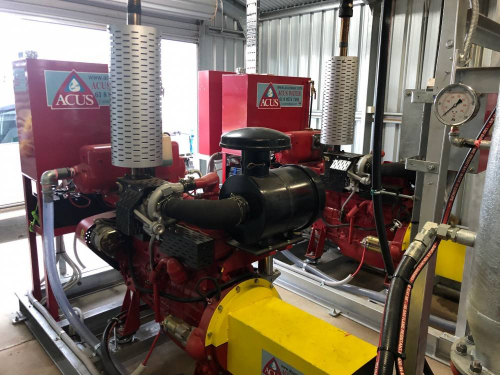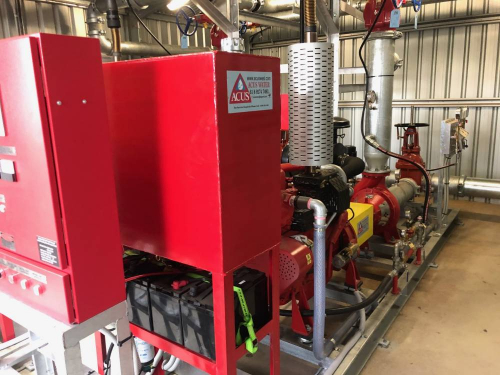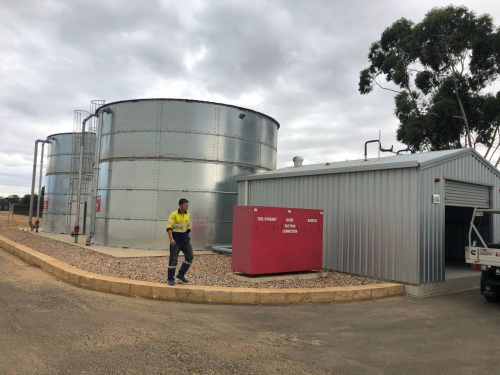- Stock for Daily Specials
- Water Proofing
- Domestic Tanks
- Domestic Tanks Parts Included
- Domestic Tanks Parts
- Design of Water Saving System
- Sand Pad Preparation
- Firewater Tanks
- Square Tanks
- Oil and Fuel
- Commercial Tanks
- Tanques Comerciales - Español
- Mining Tanks
- Industrial Tanks
- Remote Mine Camp Tanks
- Liners and Membranes
- Concrete Tank Lining
- Export Tanks
- Rainwater Tanks
- Pumps & Firewater Pumps
- Hire Tanks
- Outdoor Furniture
- Trussess Made to Order
- Sheds & Buildings
- Water Facts and Reference
- No Leaks Nigel
- ACUS Term & Conditions
- ACUS Photos
- EiFFeL
Firewater Pumps For Sale
If you're looking to buy firewater pumps, you should know that there are performance characteristics that you need to look for in firefighting pumps.
What to Look for When Buying Firewater Pumps
Regardless of how you intend to use a fire pump, whether for fighting fires or irrigation, it is important that it meets your needs in terms of performance. This is especially true if you live near or run a business near bushfire zones.
What to Look for in Fire Fighting Pumps
-
Pressure Rate
Fire fighting pumps come in different pressure rates and what you choose will depend on the purpose. For instance, if you only need a fire pump for equipment wash down or irrigation, a pressure of 100 PSI or above is acceptable.
A unit used for fighting fires should have a minimum pressure of 200 PSI (13.8 bar) above the maximum discharge pressure.
If a garden hose discharges water at about 30 to 40 PSI, you can easily tell the difference with fire fighting pumps.
In case the pumps for sale do not indicate the pressure rate, take a look at the maximum head and multiply that number by 1.42. This will give you a result in PSI.
-
Flow Rate
This refers to the volume of water that needs to be moved and the distance with which it will be pumped. A fire fighting pump for domestic use has a flow rate of anywhere between 200 litres per minute to 1000.
The flow rate is also dependent on the size of the pipe and the maximum head. A pipe that measures 100 mm, for example, will have a flow of 2,223 litres per minute, while a 300-mm pipe will have a 20,023 L/min of flow rate.
-
Maximum Head
This refers to the maximum height that a fire fighting pump can pump to. A 60-metre maximum head, for example, will have a flow rate that starts from 0 to 60 metres. When shopping for fire fighting pumps, you need to consider the maximum head and the difference in height between the pump and where you will pump water.
Maximum head will also tell you what fire pumps can do in terms of suction height plus uplift.
In calculating the maximum head, you should consider the distance between the water source and where you draw water up and the small loss due to friction.
So if you need to move water at a height of 25 metres and the water source is 5 metres away, you should choose a pump with a maximum head greater than 30 metres.
It is also important to remember that distance will compromise pressure upon discharge, so make sure to choose fire pumps that meet your requirements.
-
Size of inlet or outlet
Fire pumps for would typically have inlet/outlet sizes that range from 1 to 4. Some are even bigger. The size of the pump outlet will dictate how fast the job gets done. A 3-inch pump, for example, will get the job done 3 times faster than 1-inch pump.
Armed with this knowledge, shopping for fire pumps will be easier.



No Leaks NIGEL T WARIN
DESIGN ENGINEER PROFESSIONAL
0488741446
ACUS TANK PTY LTD

